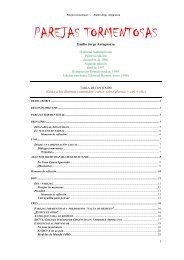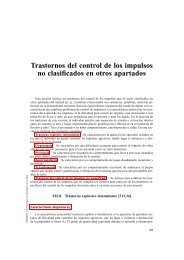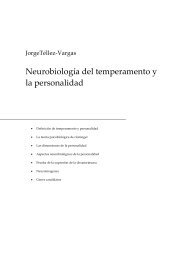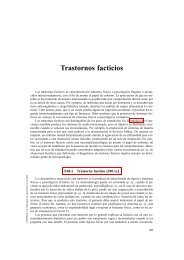Descarga
Descarga
Descarga
Create successful ePaper yourself
Turn your PDF publications into a flip-book with our unique Google optimized e-Paper software.
FUNDAP | ex - IAEPD 49<br />
| PERSONA<br />
logical, or social influences that act to prevent the development of the disorder. Paris<br />
thinks that temperament can predispose each child to certain difficulties but that temperament<br />
characteristics in the presence of psychological risk factors, such as trauma,<br />
loss and parental failure, could become amplified. As an illustrated example he<br />
explains that most shy children (temperament) grow out of normal shyness but if the<br />
family environment is unsupportive, introversion can become accentuated (trait) and<br />
with time, if they persist, become pathological (disorder). Shyness can lead a child to<br />
establish social contacts characterized by anxiety and/or withdrawal, and an abnormal<br />
attachment pattern. But if this persists, the behaviors can begin to correspond to the<br />
criteria for personality disorders of the dependent and avoidant types.<br />
Another interesting aspect that Paris points out is that the future BPD patient would<br />
begin life with temperamental characteristics that are compatible with normality (for<br />
example, a child more inclined toward action than reflection); but given a reasonably<br />
adequate psychosocial environment, they might never develop a personality disorder.<br />
He also states that parents of the future borderline patients might themselves have<br />
personality disorders, they might be insensitive to the needs of their children and fail<br />
to provide an adequate holding environment. Positive experiences with secure attachment<br />
figures can be one of the most effective protective social factors (Mosquera y<br />
Gonzalez, 2009b, 2011).<br />
Allen (2003) talks about parental role confusion. He describes how the parents of<br />
BPD are seemingly focused on their children nearly to the point of obsession, yet<br />
simultaneously angry with them. One way to understand the parent’s contradictory<br />
and seemingly irrational behavior within the families of BPD patients is to conceptualize<br />
it as a reaction to a severe and highly pervasive intrapsychic conflict over the parenting<br />
role. This conflict is created and reinforced by the parents’ experience within<br />
their own families of origin. Ambivalence over being a parent is the parent’s core conflictual<br />
relationship theme (Luborsky & Crits-Cristoph, 1990). They feel as if it they<br />
solemn duty to sacrifice everything for their children, but at the same time they feel<br />
overwhelmed by the responsibility and resentful of the sacrifices.<br />
All in all, attachment difficulties cannot completely explain the complexity of BPD<br />
and are not the only factor for a person to develop BPD, even though it is a piece of<br />
the puzzle (Mosquera, D., Gonzalez, A., 2009b).<br />
GENETIC AND BIOLOGICAL FACTORS<br />
To understand the role of early environmental aspects in personality development<br />
is not a denial of constitutional factors. A debate between constitutional versus environmental<br />
origins of mental disorders is not the goal of this article. We understand<br />
that genetic aspects influence character traits, and temperament interacts with environmental<br />
elements in a complex way. Some very extreme character traits (i.e.: an<br />
extreme impulsivity) may generate personality disorders with little environmental contribution.<br />
We believe the majority of the cases are in the middle of the spectrum,<br />
where insecure relationships with primary caregivers and the presence of traumatizing<br />
situations could drive the individual to develop a borderline personality.<br />
In order to design a truly comprehensive theory, it is important to include the role<br />
of genetic factors. But there are different data from different researches. Plomin,<br />
DeFries, McClearn and McGuffin (2001) state that genes account for 40–60% of the<br />
variability in normal personality traits. These normal personality traits could develop<br />
in a personality disorder when the individual grows with a dysfunctional attachment<br />
or a traumatic environment.<br />
Relations between attachment, genetics and personality disorders are complex and<br />
have not been established. We can consider that insecure attachment causes emotional<br />
dysregulation. But both insecure attachment and emotional dysregulation could be<br />
mediated by the same heritable differences in temperament or personality traits<br />
(Goldsmith & Harman, 1994). Recently, the influence of environmental factors in phenotypic<br />
range of gene expression has been outlined (Lobo & Shaw, 2008). This aspect<br />
needs to be studied with regard to early attachment versus genetics in the development<br />
of BPD. However, the interaction between genetics and environment probably is<br />
even more complex than has been assumed. Brussoni, Jang, Livesley and MacBeth<br />
(2000) found that genes accounted for 43, 25 and 37% of the variability in fearful, preoccupied<br />
and secure attachment. Variability in dismissing attachment, in contrast, was












